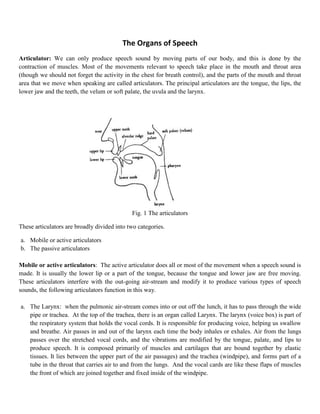
106 the organ of speech
- 1. The Organs of Speech Articulator: We can only produce speech sound by moving parts of our body, and this is done by the contraction of muscles. Most of the movements relevant to speech take place in the mouth and throat area (though we should not forget the activity in the chest for breath control), and the parts of the mouth and throat area that we move when speaking are called articulators. The principal articulators are the tongue, the lips, the lower jaw and the teeth, the velum or soft palate, the uvula and the larynx. Fig. 1 The articulators These articulators are broadly divided into two categories. a. Mobile or active articulators b. The passive articulators Mobile or active articulators: The active articulator does all or most of the movement when a speech sound is made. It is usually the lower lip or a part of the tongue, because the tongue and lower jaw are free moving. These articulators interfere with the out-going air-stream and modify it to produce various types of speech sounds, the following articulators function in this way. a. The Larynx: when the pulmonic air-stream comes into or out off the lunch, it has to pass through the wide pipe or trachea. At the top of the trachea, there is an organ called Larynx. The larynx (voice box) is part of the respiratory system that holds the vocal cords. It is responsible for producing voice, helping us swallow and breathe. Air passes in and out of the larynx each time the body inhales or exhales. Air from the lungs passes over the stretched vocal cords, and the vibrations are modified by the tongue, palate, and lips to produce speech. It is composed primarily of muscles and cartilages that are bound together by elastic tissues. It lies between the upper part of the air passages) and the trachea (windpipe), and forms part of a tube in the throat that carries air to and from the lungs. And the vocal cards are like these flaps of muscles the front of which are joined together and fixed inside of the windpipe.
- 2. b. The pharynx: The pharynx is a tube which begins just above the larynx. It is about 7 cm long in women and about 8 cm in men, and at its top end it is divided into two, one part being the back of the mouth and the other being the beginning of the way through the nasal cavity. c. The Tongue: the most important organ in the oral cavity is the tong. It is most flexible of articulators. It is often called tutor tong because it has great flexibility for variety of movements for production of human speech. For phonetic convenience, the tong is said to be divided into four parts like back, front, tip, and blade. The back and the front of the tongue lie under the soft and hard plate respectively when the tong is at rest. The tip is the front edge of the tongue and the blade is positioned between the tip and the front. The tip and the blade are highly mobile and can touch the lips, the teeth, the alveolar ridge and the hard plate. Fig. 2 Sub-divisions of the tongue d. The uvula: The uvula is a little lump of soft tissue that we can observe in the back of your mouth dangling from the end of your soft palate. It is something that the human race could probably manage perfectly well without, but one of the few useful things it does is to act as a place of articulation for a range of consonants articulated in the back of the mouth. There are uvular plosives: the voiceless one q is found as a phoneme in many dialects of Arabic, while the voiced one g is rather more elusive. Uvular fricatives are found quite commonly: German, Hebrew, Dutch and Spanish language. The uvula itself moves only when it vibrates in a uvular trill. e. The Lower lip: The lower lip can be moved to produce different sounds. It can make contact with the upper lip to produce sound. 2. The passive articulators: Articulators are the parts of the body that are used in the production of speech. Some of these can be moved, while others are fixed. Fixed articulators are sometimes called passive articulators, and their most important function is to act as the place of an articulator’s stricture. a. The upper lip: In speech production, it is lower lip that reaches up to make contact with it and create different sound. b. The upper teeth: The lower lip, tongue tip and blade from constrictor with the row of the upper teeth. Two upper front teeth are used for production of some consonant speech sound. c. Alveolar ridge: Behind the upper front teeth there is a hard, bony ridge called the alveolar ridge. It is that part of gums that lies immediately behind the upper front teeth. d. Hard plate: The hard palate is a thin horizontal bony plate of the skull, located in the roof of the mouth. It is important for speech. The interaction between the tongue and the hard palate is essential in the formation of certain speech sounds, notably /t/, /d/, /j/, and /ɟ /. e. Soft plate: The soft plate is soft and flexible organ. Its chief function consists of opening the naso- pharyngeal cavity by lowering itself to produced “nasal” sounds. When the soft palate is raised air can pass trough it freely.
